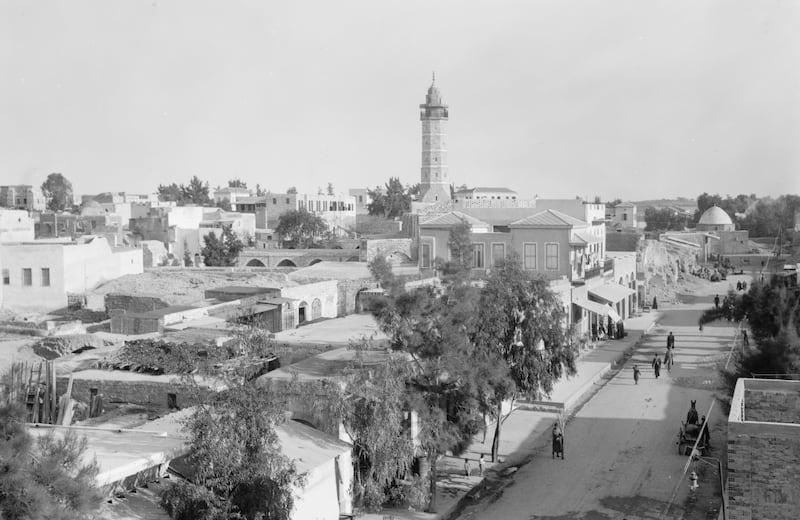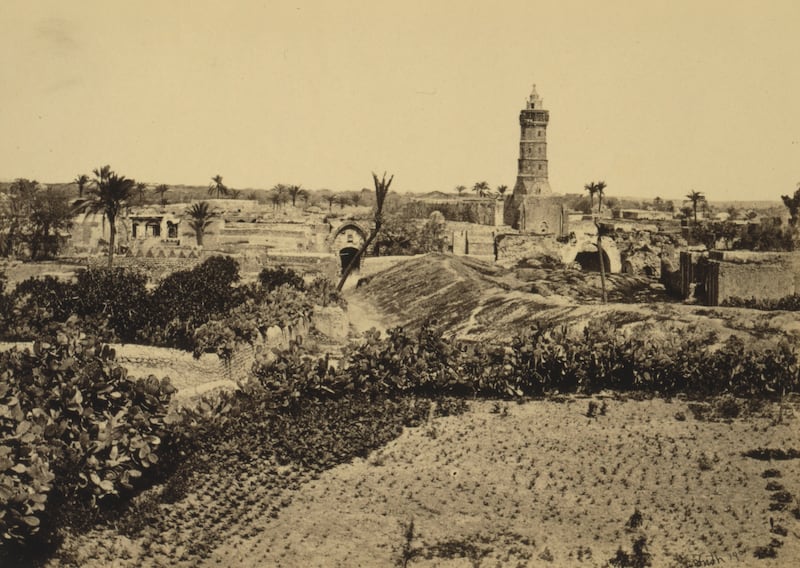Perhaps no structure so exemplified the rich, interwoven history of the Gaza Strip as the Great Omari Mosque, believed by many to be the oldest in the territory.
As empires waned, religious buildings on the site – first pagan, then Christian and Muslim – were destroyed or repurposed. The mosque was rebuilt many times, surviving not only as a beloved centre for Islamic faith and learning, but also as a symbol of resilience.
In December the mosque was all but destroyed in an air strike by the Israeli military, which claimed the site had become a command centre for Hamas.
Palestinians say they lost not only a critical anchor to their past, but also a place for the present, a public space for prayer and contemplation, for wedding announcements and soccer games. That vitality is evident in the many images created over the centuries by illustrators and photographers who sought to capture its central role in Gaza life.
The mosque site in the heart of Gaza city has been a place of worship for thousands of years, dating back, according to some accounts, to the Philistines whose temple walls were said to have been pulled down by Samson, the Israelite warrior.
A Christian Byzantine church erected in the fifth century on top of the ruins of an earlier Roman temple was repurposed in the seventh century as a mosque following the Muslim conquest of Gaza. Some researchers suggest the space may have served both Muslims and Christians during this period. But that building was destroyed when Gaza fell to the Crusaders around 1100, and a church was later built at the site. Parts of the church, in particular its central nave, were repurposed as a mosque in the 12th century when Muslims regained control of Gaza.
Over the centuries that followed, the building often suffered serious damage from invaders and earthquakes. But it was constantly rebuilt and expanded, first by the Mamluks, who created a powerful Islamic empire during the later Middle Ages, and later the Ottomans. The Mamluk efforts included the addition of a stone arcade to align the eastern wall toward Mecca and the design of an octagonal minaret. The Ottoman contributions included walls added to the courtyard.
Among scholars the mosque became known for its expansive library of ancient Islamic manuscripts, including religious texts, literature and social and political commentary.
The library and much of the rest of the mosque were destroyed in 1917 by a British artillery bombardment during the first World War. The British said they were targeting an Ottoman arms depot inside the mosque, and they would go on to capture the rest of the area.

The sandstone building, including its library and minaret, was rebuilt roughly a decade later under a restoration authorised by the Supreme Muslim Council that employed the very fabric of the mosque’s history, such as surviving remnants from the Crusader church and the Mamluk arcade.
One interior column once featured a bas-relief with Jewish ritual symbols, though many experts do not believe the site was ever used as a synagogue. Rather, they say, that column possibly originated in an ancient synagogue somewhere in the region and was reused during the building’s reconstruction.
Over the centuries, the courtyard outside became a plaza for much more than prayer.
“Faith-based organisations play an important role in the lives of the people,” says Jehad Abusalim, a Palestinian historian who grew up in Gaza. “For the exchange of ideas. They’re not just for prayer. They’re also places for celebrating life.
“People meet there and gather. And so, in a way, it was part of the life of the community. It was a community centre in every sense of the word.”
The Israeli air strike hit the mosque in the late morning of December 4th, 2023, about two months after the Hamas attack on October 7th, which Israeli authorities say killed 1,200 people. Much of the building was reduced to rubble.
[ Gaza conflict has caused major environmental damage, UN saysOpens in new window ]
When the smoke cleared, the stone arcade built by the Mamluks survived in some measure. So did sections of some walls. The minaret was still standing, though its top had been blown off. There was no longer a roof on the building.
The manuscript library, which had been kept in several rooms, had been left in tatters. But before the air strike, many of the manuscripts it housed had been moved to other locations, though one of them, a restoration centre, was also damaged in the fighting.
In the neighbourhood of the mosque, the compound of the historic Greek Orthodox Church of St Porphyrius, the oldest active church in Gaza, has also been struck in the Israeli military offensive. It is among the 43 religious or historic sites damaged since October 7th, according to the latest assessment of damage by Unesco.
The war has been devastating, with more than 35,000 people killed in Gaza, many of them women and children, according to local health authorities. The Israeli military has said the air strikes and invasion have been necessary to dismantle Hamas.
In the case of the mosque, the Israeli military said it was a Hamas command centre, a necessary military target that was fed by a tunnel shaft. “Hamas has spent years embedding its own terror infrastructure into and under civilian areas, including hospitals, mosques, schools, and other religious and historical sites,” the Israeli military said in a statement.
In early December the city’s historic district constituted a front line as the Israeli military made a push from the east. Its claims about the use of the mosque by Hamas fighters could not be independently verified and the Israeli military did not respond to a request for evidence.

The destruction of the built environment in Gaza has been so pervasive that, by early May, at least 57 per cent of all buildings in the territory had been either damaged or destroyed, according to an analysis of satellite data by US researchers.
But the loss of some buildings registers on a scale far above others, even for people displaced, struggling to find food and contending with a massive loss of life.
“They’re living under this sky and the bombarding without food,” says Akram M Lilja, a Palestinian archaeologist and former cultural heritage official, who says he has spoken to friends and family who lived near the mosque. “Once they heard about the Al-Omari Mosque story, they started to cry.”
Isber Sabrine, president of Heritage for Peace, a non-profit that promotes the protection of cultural sites, argues that whenever restoration efforts in Gaza begin, rebuilding the mosque should be a priority. “I know what it means,” he says. “It is not just a place. It is an entire memory of a people.”
The effort to protect cultural heritage during war has been under way for more than a century, with varying success. Allied bombing runs in the second World War steered clear of the Duomo cathedral in Florence, Italy, to protect that masterpiece of Renaissance architecture. But the Allies at the same time destroyed Monte Cassino, one of Italy’s oldest monasteries, on the suspicion that it was a Nazi observation point.
Under the 1954 Hague Convention for the Protection of Cultural Property in the Event of Armed Conflict, which Israel ratified, countries around the world pledged to protect cultural sites during conflict by establishing procedures to safeguard them.
But critics say Israel has flouted that promise with indiscriminate attacks in Gaza that display disregard, not only for civilian lives, but for the sanctity of sites that have defined civilisation there for centuries.
South Africa pointed to the destruction of the Great Omari Mosque in arguing before the International Court of Justice that the elimination of cultural sites was part of a broader pattern of Israeli genocide that would leave displaced Palestinians with nothing to return to.
Israel has denied that and argues that Hamas is to blame for embedding its fighters amid homes and cultural sites.
In a statement, the Israeli military said its commanders employ a comprehensive evaluation process, assisted by lawyers, to “ensure that strikes comply with international legal obligations, including proportionality”. The process includes detailed regulations for “sensitive sites”, the statement said, and the use of Target Cards that “facilitate an analysis that is conducted on a strike-by-strike basis, and takes into account the expected military advantage and the likely collateral civilian harm, amongst other matters”.
That level of care is not evident in the images coming from Gaza, says Peter Stone, president of the Blue Shield, an independent non-profit group that works to protect cultural heritage in conflict zones.
“From what we have seen in Gaza, it appears that they have almost taken no consideration of trying to protect cultural property. This is the outside view, from satellite imagery and talking to Palestinian sources,” says Stone.
Destroying cultural heritage can be self-defeating because it bestows a propaganda victory on your enemy while also inciting the unwavering resentment of the people who suffered such losses, he says. “What you are doing is creating the reason for the next conflict.” – This article first appeared in The New York Times
2024 The New York Times Company



















